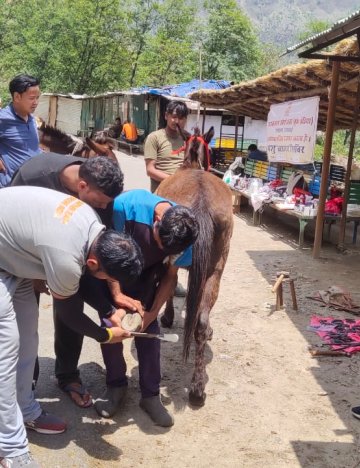Brooke India assists Himalayan community with “hazardous” equine migration
Brooke India is supporting equine-owning communities in the Himalayas with essential veterinary care, as they make the hazardous migration to new land for their animals to graze.
Brooke India and local Government Veterinary and Livestock Extension Officers perform vital health check-up for a Bhotia Tribe equine. Credit: Vikram Mehta, Field Assistant.
Every summer, the Bhotia Tribe in the State of Uttarakhand travel with their livestock to the “Bugyals” (remote pastures in the Himalayan Mountains), as the largest equine-owning community in the region. These animals are used to transport resources, travel and camping equipment, facing difficult conditions with elevations ranging from 10 to 13 thousand feet and extreme temperature conditions.
Brooke India, with the support of local Government Veterinary and Livestock Extension Officers, have set up a camp offering health check-ups for the Bhotia Tribe’s equines, including hoof trimming, deworming and emergency treatments before they travel.
Brooke also gives First Aid training to the community, offers medical kits and helps to prepare for animal health emergencies.
As the largest equine-owning community in this area, it is very important for Brooke to support the Bhotia Tribe, who are in need of economic support and veterinary services. We walk very closely with this community, to help improve the wellbeing of equines and their owners.
Dr Kimmi Thapa is Project Officer at Brooke India and is leading the Equine Welfare Project in Uttarakhand. Here, she shares her experience when assisting with the migration.
Why is it important for you to help this community migrate?
“The journey to the Bhotia Tribe’s remote summer abode is arduous. The community stays at this higher altitude for about six months, away from main civilisation. The remote location makes it difficult for the tribe to access medicines or veterinary care for their equines. With the intervention of health camps on the way to the Bugyals, we ensure equine well-being and health. The tribe is equipped with resources and treatment methods, so that they can offer better care to their equines during times of sickness or emergency.”

What challenges have you faced?
Difficult Geographical terrain - “The site of our intervention is geographically challenging. It is difficult to access with very poor transport connections. The site also has low connectivity and mobile networks.”
Aggressive animals – “The Bhotia’s equines can be aggressive due to lack of proper handling methods and practices. They are left in the wild to graze for a few months, and can be difficult to tame once brought back from the wilds to work at Bugyal. This can make it difficult for vets to conduct check-ups or for farriers to shoe the animal.”
Shoeing and hoof-related issues – “Hoof-related issues are common among the equines of the Bhotia tribe. Due to a lack of awareness and access to appropriate resources, shoeing isn’t performed at regular intervals, which has caused serious hoof problems among the equines of the tribe.”
Saddlery wounds – “Due to the transportation of heavy items and constant usage, saddle cloth used by equine’s owners can often wear thin, often causing discomfort to the animals.”
“Other reasons for saddlery wounds include lack of regular cleaning or replacement of worn-out saddlery cloth, and lack of timely or proper management of equine wounds with the proper medicines.”
Dr. Khalid Malik, Government Veterinary Officer in Uttarakhand agrees that “the Bugyal camp is an important initiative to support equines in the higher altitude of the Himalayas. Brooke India has supported us to ensure better veterinarian services for equines in this difficult geography, and create a sustainable system to promote equine wellbeing in the future.”
